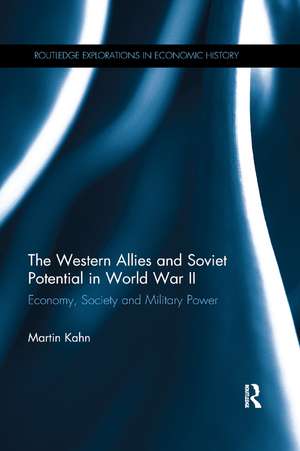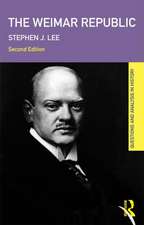The Western Allies and Soviet Potential in World War II: Economy, Society and Military Power: Routledge Explorations in Economic History
Autor Martin Kahnen Limba Engleză Paperback – 12 dec 2019
This book examines how the two most important Western Allies in World War II, the United States and the United Kingdom, assessed the economic and military potential of the Soviet Union in 1939–1945. Since the USSR was the single most important military contributor to the Allied victory in Europe, and the main target of Germany’s military strength, these assessments are of paramount importance in order to understand how the Anglo-Americans perceived the overall war situation and adjusted their own war effort in accordance with it. Utilising a wide range of documents produced by the Anglo-Americans during and shortly before World War II, this book explores why Soviet strength was underestimated, and how the Soviet economic system, Soviet society and military capabilities were viewed by Western Government observers.
The Western Allies and Soviet Potential in World War II is a fascinating read for those in academia studying economic history, international economics and security studies, especially areas on military and strategic.
| Toate formatele și edițiile | Preț | Express |
|---|---|---|
| Paperback (1) | 389.66 lei 43-57 zile | |
| Taylor & Francis – 12 dec 2019 | 389.66 lei 43-57 zile | |
| Hardback (1) | 1007.36 lei 43-57 zile | |
| Taylor & Francis – 22 mar 2017 | 1007.36 lei 43-57 zile |
Din seria Routledge Explorations in Economic History
- 9%
 Preț: 934.30 lei
Preț: 934.30 lei -
 Preț: 154.97 lei
Preț: 154.97 lei -
 Preț: 310.96 lei
Preț: 310.96 lei -
 Preț: 380.85 lei
Preț: 380.85 lei -
 Preț: 309.12 lei
Preț: 309.12 lei -
 Preț: 326.97 lei
Preț: 326.97 lei -
 Preț: 371.51 lei
Preț: 371.51 lei -
 Preț: 312.65 lei
Preț: 312.65 lei -
 Preț: 310.84 lei
Preț: 310.84 lei -
 Preț: 325.09 lei
Preț: 325.09 lei - 8%
 Preț: 390.79 lei
Preț: 390.79 lei -
 Preț: 422.00 lei
Preț: 422.00 lei - 18%
 Preț: 1113.95 lei
Preț: 1113.95 lei - 25%
 Preț: 824.17 lei
Preț: 824.17 lei - 18%
 Preț: 1067.84 lei
Preț: 1067.84 lei - 21%
 Preț: 304.74 lei
Preț: 304.74 lei - 18%
 Preț: 1056.95 lei
Preț: 1056.95 lei -
 Preț: 419.50 lei
Preț: 419.50 lei - 29%
 Preț: 1193.01 lei
Preț: 1193.01 lei - 18%
 Preț: 1055.21 lei
Preț: 1055.21 lei - 18%
 Preț: 1175.51 lei
Preț: 1175.51 lei - 25%
 Preț: 766.65 lei
Preț: 766.65 lei - 18%
 Preț: 1433.54 lei
Preț: 1433.54 lei - 18%
 Preț: 1163.63 lei
Preț: 1163.63 lei -
 Preț: 484.47 lei
Preț: 484.47 lei - 25%
 Preț: 997.11 lei
Preț: 997.11 lei - 18%
 Preț: 1385.39 lei
Preț: 1385.39 lei - 25%
 Preț: 855.59 lei
Preț: 855.59 lei - 18%
 Preț: 1077.57 lei
Preț: 1077.57 lei - 18%
 Preț: 1166.80 lei
Preț: 1166.80 lei - 18%
 Preț: 1126.82 lei
Preț: 1126.82 lei - 25%
 Preț: 851.46 lei
Preț: 851.46 lei - 18%
 Preț: 1175.01 lei
Preț: 1175.01 lei - 42%
 Preț: 195.71 lei
Preț: 195.71 lei - 18%
 Preț: 1059.84 lei
Preț: 1059.84 lei - 18%
 Preț: 1057.05 lei
Preț: 1057.05 lei - 18%
 Preț: 1334.10 lei
Preț: 1334.10 lei - 43%
 Preț: 216.41 lei
Preț: 216.41 lei - 26%
 Preț: 822.54 lei
Preț: 822.54 lei - 18%
 Preț: 1168.09 lei
Preț: 1168.09 lei - 25%
 Preț: 1482.69 lei
Preț: 1482.69 lei - 18%
 Preț: 1164.92 lei
Preț: 1164.92 lei -
 Preț: 485.99 lei
Preț: 485.99 lei - 18%
 Preț: 1065.06 lei
Preț: 1065.06 lei - 18%
 Preț: 1058.79 lei
Preț: 1058.79 lei - 18%
 Preț: 1064.70 lei
Preț: 1064.70 lei - 26%
 Preț: 821.53 lei
Preț: 821.53 lei
Preț: 389.66 lei
Nou
Puncte Express: 584
Preț estimativ în valută:
74.56€ • 78.05$ • 62.06£
74.56€ • 78.05$ • 62.06£
Carte tipărită la comandă
Livrare economică 31 martie-14 aprilie
Preluare comenzi: 021 569.72.76
Specificații
ISBN-13: 9780367873738
ISBN-10: 0367873737
Pagini: 356
Dimensiuni: 156 x 234 x 19 mm
Greutate: 0.45 kg
Ediția:1
Editura: Taylor & Francis
Colecția Routledge
Seria Routledge Explorations in Economic History
Locul publicării:Oxford, United Kingdom
ISBN-10: 0367873737
Pagini: 356
Dimensiuni: 156 x 234 x 19 mm
Greutate: 0.45 kg
Ediția:1
Editura: Taylor & Francis
Colecția Routledge
Seria Routledge Explorations in Economic History
Locul publicării:Oxford, United Kingdom
Public țintă
Postgraduate and UndergraduateCuprins
Abbreviations
1 Introduction
1.1 General background
1.2 War potential and the general purpose of this study
2 The Anglo-American assessments in a wider context
2.1 The US and British government organizations responsible for assessing the USSR
2.2 The origins, analysis and dissemination of information
2.3 The assessment’s reliability and the selection of reports for this study
2.4 The reality and contemporary perceptions of war potential
3 The Soviet Union and the West: The pre-war experience and international Great Power politics before World War II
4 From the guarantee to Poland to the Molotov-Ribbentropp pact
4.1 British anguish: The value of the Soviet Union as an ally and the "gathering storm" in Europe
4.2 Soviet war potential and the possible inclusion of the USSR in a "peace front"
4.3 The Soviets propose an alliance
4.4 Assessments on the eve of the Moscow negotiations
5 US pre-Barbarossa assessments
5.1 The economy and its military potential
5.2 The size and efficiency of the armed forces
5.3 Internal stability
6 The Molotov-Ribbentrop pact and its consequences
6.1 The Polish campaign
6.2 The USSR as a potential military adversary
6.3 The Red Army enter Estonia
6.4 Assessments regarding the economy during the autumn
6.5 Soviet air strength – autumn assessments
6.6 Assessments connected to the Soviet–Japanese conflict
6.7 Anglo-French plans to interdict the Soviet oil supply
7 The Soviet–Finnish Winter War
7.1 The Red Army’s performance
7.2 The economy and the internal situation
8 Assessments running up to Barbarossa
8.1 The economy and internal stability
8.2 The production and quality of munitions
8.3 Milita
1 Introduction
1.1 General background
1.2 War potential and the general purpose of this study
2 The Anglo-American assessments in a wider context
2.1 The US and British government organizations responsible for assessing the USSR
2.2 The origins, analysis and dissemination of information
2.3 The assessment’s reliability and the selection of reports for this study
2.4 The reality and contemporary perceptions of war potential
3 The Soviet Union and the West: The pre-war experience and international Great Power politics before World War II
4 From the guarantee to Poland to the Molotov-Ribbentropp pact
4.1 British anguish: The value of the Soviet Union as an ally and the "gathering storm" in Europe
4.2 Soviet war potential and the possible inclusion of the USSR in a "peace front"
4.3 The Soviets propose an alliance
4.4 Assessments on the eve of the Moscow negotiations
5 US pre-Barbarossa assessments
5.1 The economy and its military potential
5.2 The size and efficiency of the armed forces
5.3 Internal stability
6 The Molotov-Ribbentrop pact and its consequences
6.1 The Polish campaign
6.2 The USSR as a potential military adversary
6.3 The Red Army enter Estonia
6.4 Assessments regarding the economy during the autumn
6.5 Soviet air strength – autumn assessments
6.6 Assessments connected to the Soviet–Japanese conflict
6.7 Anglo-French plans to interdict the Soviet oil supply
7 The Soviet–Finnish Winter War
7.1 The Red Army’s performance
7.2 The economy and the internal situation
8 Assessments running up to Barbarossa
8.1 The economy and internal stability
8.2 The production and quality of munitions
8.3 Milita
Descriere
This book examines how the two most important Western Allies in World War II, the United States and the United Kingdom, assessed the economic and military potential of the Soviet Union in 1939-1945. Utilising a wide range of documents produced by the Anglo-Americans during and shortly before World War II, the book explores why Soviet strength wa












